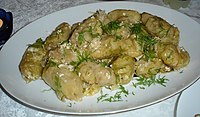Cabbage roll

A cabbage roll (also stuffed cabbage) is a dish consisting of cooked cabbage leaves wrapped around a variety of fillings. It is common to the ethnic cuisines of the Balkans and parts of Eastern Europe and the Middle East as well as Finland and Sweden.
In Europe, the filling is traditionally based around meat, often beef, lamb, or pork and is seasoned with garlic, onion, and spices. Grains such as rice and barley, eggs, mushrooms, and vegetables are often included. Pickled cabbage leaves are often used for wrapping, particularly in Southeastern Europe. In Asia, seafoods, tofu and shiitake mushroom may also be used and Chinese cabbage are often used as a wrapping.
Cabbage leaves are stuffed with the filling which are then baked, simmered or steamed in a covered pot and generally eaten warm, often accompanied with a sauce. The sauce varies widely by cuisine. Always in Sweden and sometimes in Finland, stuffed cabbage is served with lingonberry jam, which is both sweet and tart. In Eastern Europe, tomato-based sauces or plain sour cream are typical. In Lebanon it is a popular plate, where the cabbage is stuffed with rice and minced meat and only rolled to the size of cigar. It is usually served with a side of yogurt and a type of lemon and olive oil vinaigrette seasoned with garlic and dried mint.
Popular among European Jews, and traditionally served on Simchat Torah, stuffed cabbage is described by Gil Marks to have entered Jewish cooking some 2,000 years ago.[1] Recipes vary among Jewish communities depending on region; Romanians and northern Poles prefer a savory sauce, while Jews from Galicia and Ukraine favor sweet-and-sour, for example.[2]
Variations
|
|
Croatia
Cabbage rolls are a staple diet of the population in Croatia. In a recent survey 97% of women over 25 regularly eat stuffed cabbage.[citation needed] The popularity of the dish has only recently been surpassed by a love for a hearty bean soup.[citation needed] Stuffed cabbage with ground smoked pork is a firm Croatian favorite at Christmas.[citation needed]
Poland
Stuffed Cabbage Rolls are the epitome of Polish comfort food. Pork and beef mixed with rice or barley are nestled in a cabbage leaf and cooked in the oven or on the stove until tender.
Poles call them gołąbki (gaw-WOHMP-kee), which literally means "little pigeons." For Czechs and Slovaks, it's holubky, while Serbs and Croatians refer to them as sarma. Usually, the sauce is what sets them apart.
Ukraine
Typical Ukrainian cabbage rolls can be made from either pickled or parboiled cabbage leaves. Fillings traditionally contain rice only, since the typical peasant diet was largely vegetarian due to the higher cost of meat. Occasionally, the rice filling is mixed with small amounts of meat. Other recipes call for cooked kasha and chopped wild mushrooms or, more recently, combinations of whole grains and root vegetables. Some modern recipes call for tofu or textured vegetable protein instead of meat. The finished rolls may be simmered in thinned tomato juice, beef stock, vegetable stock, or even miso broth.[4]
Russia
The Russian version of cabbage rolls usually consists of cooked meatballs wrapped in cabbage leaves. Rice is commonly added to the stuffing as well, but stuffing the rolls with rice only is rare. In order to save time there is another variation of that dish called "lenivye golubtsy" (lazy cabbage rolls). In that case, the cabbage is chopped and put inside the meat so there is no need to wrap every meatball in a cabbage leaf.[5]
Sweden
Kåldolmar are Swedish cabbage rolls filled with minced pork meat, and in some cases rice. They are usually eaten with boiled potatoes, gravy and lingonberry jam. Kåldolmar are also popular in Denmark and in Finland, where they are known in Finnish as kaalikääryle (plural kaalikääryleet).[6]
The dish is considered to be a variety of the dolma, common in Eastern Mediterranean countries. After losing the Battle of Poltava in 1709 Charles XII of Sweden fled to the city of Bender, in Moldavia, then controlled by the Ottoman Empire. There he spent two years in exile, trying to convince the Ottoman Empire to help him defeat the Russians. Charles returned to Sweden and he was followed by some of his Ottoman creditors whom he had borrowed money from to finance his wars. The Ottoman creditors lived in Stockholm between 1716 and 1732, and during this time it is most likely that the dolma was introduced in Sweden.
It is first mentioned in a famous Swedish cookbook written by Cajsa Warg, in 1755.
In Sweden "Kåldolmens dag" (Day of the Cabbage Roll) is celebrated on 30 November, the death day of Charles XII of Sweden with the purpose stated by its initiators to hail the multifaceted Swedish cultural heritage involving national symbols with immigrant background. It is arranged by "Kåldolmens vänner" (Friends of the Cabbage Roll).
Nowadays you can buy frozen 'Kåldolmar' in any big food store.
See also
Notes
- ^ Eileen M. Lavine (September/October 2011). "Stuffed Cabbage: A Comfort Food for All Ages". Moment Magazine. Retrieved October 3, 2011.
{{cite news}}: Check date values in:|date=(help) - ^ Eileen M. Lavine (September/October 2011). "Stuffed Cabbage: A Comfort Food for All Ages". Moment Magazine. Retrieved October 3, 2011.
{{cite news}}: Check date values in:|date=(help) - ^ June Meyers Authentic Hungarian Heirloon Recipes Cookbook
- ^ Ukrainian Daughters Cookbook. Ukrainian Women's Association of Canada, Daughters of Ukraine Branch. Regina: Centax of Canada, 1984. ISBN 0-919845-13-4.
- ^ The ultimate Russian comfort food, October, 28 2009, Russia Beyond the Headlinese
- ^ Kåldolmar recipe, Nature Teaches Us: A Comenius Project
References
- Wretman, Tore: Svensk husmanskost (Forum 1967) ISBN 91-37-08274-4
